|
Tuesday, march 29'th
Leaving Warsaw central at 9 am and
arriving at Krakow
Glowny 3 hours later. My hotel - Hotel
Polonia - is just opposite the railway station. Room is not ready yet, so
time for a short walk before checkin-in.
Later another walk around the Stare
Miasto of Krakow - the old neighbourhood. This part of the town is from the 13.
century, and used to be surrounded by a solid bank. Now not much of this is
left, instead there's a nice park. Cars are not allowed in most parts of Stare
Miasto, so it's a nice area to stroll.
|
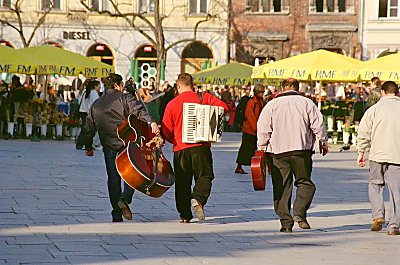 |
|
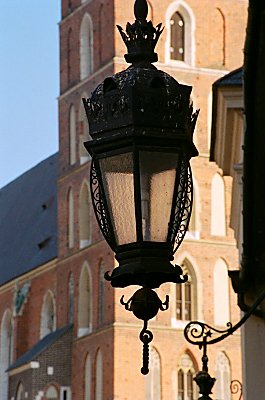 |
There's a nice marketplace - called
Rynek Glowny. The sun is shining, and the temperature is nice, so it's time for
a coffee at one of the cafe's outside. A lot of people are enjoying the cafe's,
and those that aren't are bying souvenirs in the old sokiennice - the old
markethall in the middle of the square In one corner of the square I
visit the fine St. Mary's churc. It's built from the late 13. century to the
beginning of th 15'th. They were not so much in a hurry these days. It's a
gothic church, with 2 different towers - one for the church and one for the
city. From the city-tower a trumpet-signal is played every hour. The signal
stops quite dramatically in the middle of the tune. Rumors are, that a guard
using the signal to warn of an attack on the city back in the old times,
were hit throgh his neck by the attackers, right where the signal stops
nowadays.
From the church it's out into Stare
Miasto once more. A quick look at Collegium Maius - the oldest part of the
Krakow University - before sunset, where they close down the place. |
Wednesday, march 30'th
|
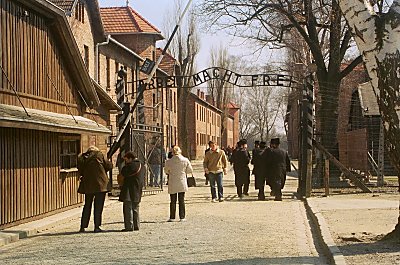 |
Bus to Oswiecim. That might say
a lot - but if you use the german term Auschwitz,
it's hopefully something different.
Arriving in Auschwitz at 11 where I take a guided tour around the area. We
start under the "Arbeit macht frei"-sign at the original Auschwitz KZ-camp -
or Auschwitz 1. A part of the camp is transferred into museums, telling the
ugly story of what happened here.
|
| From Auschwitz 1 we take a bus
the 3 km to Birkenau - or Auschwitz 2 as it also was called. It was built in
1941-42 because the original Auschwitz was to small. Birkenau is the place
you see in "Schindler's List" and "La Vita è bella".
Birkenau is huge compared to Auschwitz 1. At
the same time there could be 100.000 people out her. The nazis destroyd most
of Birkenau before leaving the place.
1 hour later the bus returns to Auschwitz 1. Here I take a walk on my own
around the area - and takes another look at the horrible museums. About 1½
mio. people died in Auschwitz, Birkenau and Monowitz - some 6 km's from
Auschwitz. |
 |
Thursday, march 31'st
|
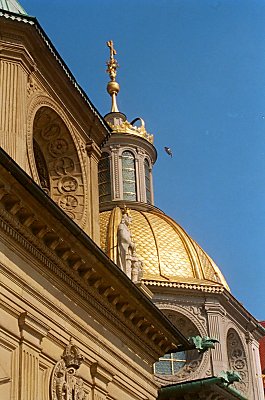 |
Until the beginning of the 17'th
century Krakow was the political and cultural center of Poland. All the kings
used to live her on the castle Wavel,
on the top of the hill just south of Stare Miasto. I take a look around this
nice castle and the Wavel-cathedral just beside. Most of the kings are now
buried here. There's also a nice tower, with a huge bell and a great view of
Krakow.
The rest of the day I spend in Stare
Miasto. Very nice place - especially the small streets and alleys.
In the evening I try to take some
pictures from the old part of the city, before a late dinner at my hotel
|
|
Friday, april 1'st
Bus to Wielicka, just outside
Krakow. Here are the impressive Wielicka
saltmines.
There's a guided tour down the
mines. You walk 70 down on some wooden stairs. From there it's a 2 km. walk
around the mines passing a lot of exiting figures, different rooms, chapels etc.
The largest room is St. Kinga's chapel. It's 50 meters long and 10 meters high
with chandalliers hanging from the ceiling. The chapel was made in 1896. I'm
especially impressed by a "painting"-lookalike of Leonardo DaVincis "The last
supper".
Everything you see down here are
made by salt - and most have been made by the workers in the mine in their
spare-time.
Back in Krakow another walk around
town. Huge number of people are gathered outside the Franciskan-church and the
home of the bishop. And plenty of international TV-crews are here. The reason is
that the pope is close to dying, and he was born near Krakow and used to be a
bishop in the city. So this is a main event here.
|
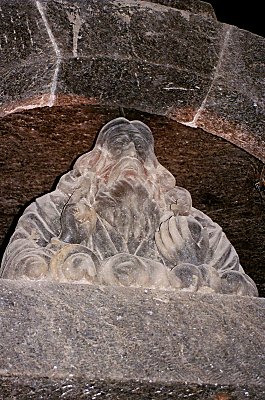 |
Saturday, 2'nd
|
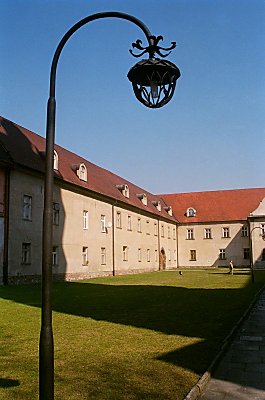 |
Krakow has suddenly turned into the
center of the universe. CNN is here, BBC is here - every bloody TV-channel is
here.
Most are gathered at the
Franciskan-church and the home of the bishop. This morning severel thousand
people was gathered here. I pass the plade on my way to the Wavel-castle once
again. This time not to see the castle but to walk through "The Dragons cave" on
my way to Kazimierz.
Kazimierz is a nice neighbourhood south of Stare Miesto. It used to be an
independent city. It's a mixture of polish and jewish neighbourhood, and there
are several nice churches and synagogues. And then of course some nice cafe's,
restaurants and beautiful squares - a nice place to stroll around for some
hours.
|
|
In the evening it's time for
something I have never tried before. A church-concert in the Bernadonow-church.
Very nice - but slightly boring.
On my way home I pass the home of the bishop again. Still thousand of people,
and almost as many candles. A mass in transmissioned to the people from inside
the church. Som munks are standing in the corner giving soup to those who need
is. When I reach my hotel I open the TV just as they annonced the death of the
Pope.
|
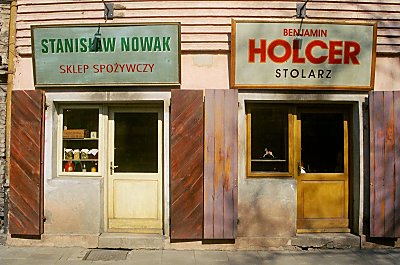 |
Sunday, april 3'rd
|
 |
Tram no. 15 to Nowa Huta
10 km east of Krakow. Nowa Huta was a communist settlement build around a
steel-work in the beginning of 1950's. No special reason to put a steelwork
here. All materials had to be transported to the place.
Around the plant they build a city
for 200.000 people. It's terribly ugly. But they forgot one thing - a church.
And the polish people wasn't happy about that. The local bishop - and later pope
- started to celebrate masses in the outdoors, before the the communist allowed
a church to be built in 1977
|
|
Back in Krakow it's time for another
walk in the city. All churches are full only standing space outside. And the
media-people are still here covering the thing. And even my favourite
pop-radiostation is playing classical music for mourning all day long
To Prague
|
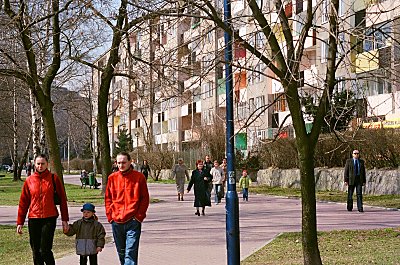 |
|